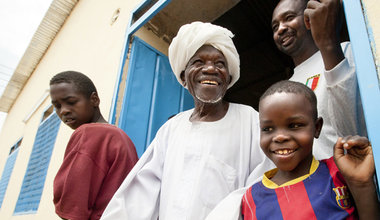13 May
2013
Community
Building Peace in Darfur’s Communities
To support peace efforts in Darfur at the community level, UNAMID’s Disarmament, Demobilisation and Reintegration (DDR) section has been implementing strategies designed to reduce violence and increase vocational opportunities for young people.
By Caterina Violante
In most peacekeeping operations, the process of disarmament, demobilisation and reintegration (DDR) works within the framework of a comprehensive peace agreement to disarm combatants and help them find new life as valuable and contributing members of society. When there is no comprehensive peace agreement in place, as is the case in Darfur, DDR efforts focus on community-oriented programmes designed to set the stage for formal DDR activities, fostering trust at local levels and supporting programmes to move the peace process steadily forward.
The Doha Document for Peace in Darfur (DDPD) has not yet been signed by all armed movements, making comprehensive DDR activities impossible. However, UNAMID’s DDR section has been working through the framework of what has come to be known as second-generation DDR, which offers different strategy and policy options that rely on unique approaches considered more effective for specific contexts. Rather than focusing on formal DDR activities, second-generation DDR takes a more organic approach in focusing on peace and security at the community level, and ensuring the involvement of these communities in the peace process.
As one part of this second-generation approach to support peace in Darfur at the community level, UNAMID’s DDR section has been implementing a violence-reduction strategy that has taken several forms in practice, most notably in community-based, labour-intensive projects (CLIPs). These community projects are designed to support the efforts of the Government of Sudan in addressing the needs of at-risk youth and other vulnerable groups in communities and in camps for displaced people. The projects focus not only on building vocational skills, and in many cases facilitating infrastructure development, but also on fostering reconciliation across Darfur.
 On 29 April 2013 in the Althoura Shemal neighbourhood on the outskirts of El Fasher, North Darfur, a community leader, Mr. Mohammed Khalil, celebrates an event with the men, women and children of Althoura Shemal in the completed community centre built in one of UNAMID’s community-based, labour-intensive projects (CLIPs). This building project, facilitated by UNAMID’s Disarmament, Demobilisation and Reintegration section, provided vocational training to 80 young people—60 men and 20 women. Photo by Albert González Farran, UNAMID.
On 29 April 2013 in the Althoura Shemal neighbourhood on the outskirts of El Fasher, North Darfur, a community leader, Mr. Mohammed Khalil, celebrates an event with the men, women and children of Althoura Shemal in the completed community centre built in one of UNAMID’s community-based, labour-intensive projects (CLIPs). This building project, facilitated by UNAMID’s Disarmament, Demobilisation and Reintegration section, provided vocational training to 80 young people—60 men and 20 women. Photo by Albert González Farran, UNAMID.
 UN
UN United Nations Peacekeeping
United Nations Peacekeeping


